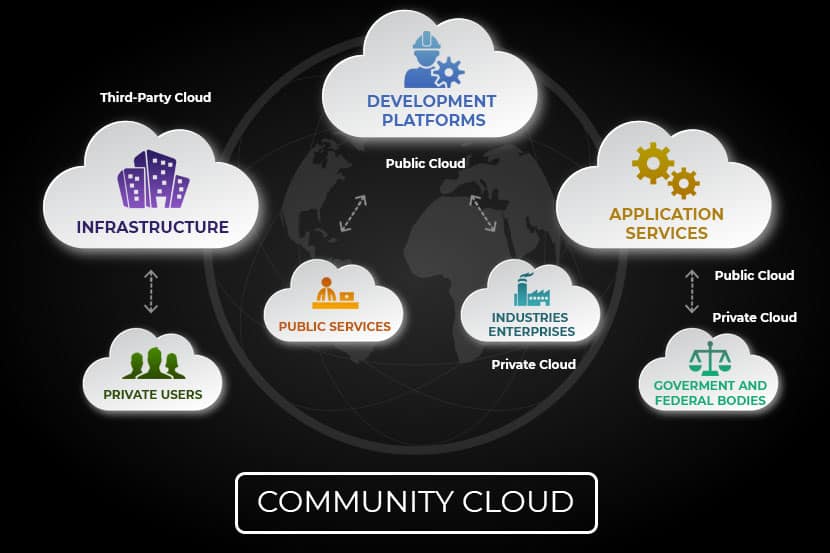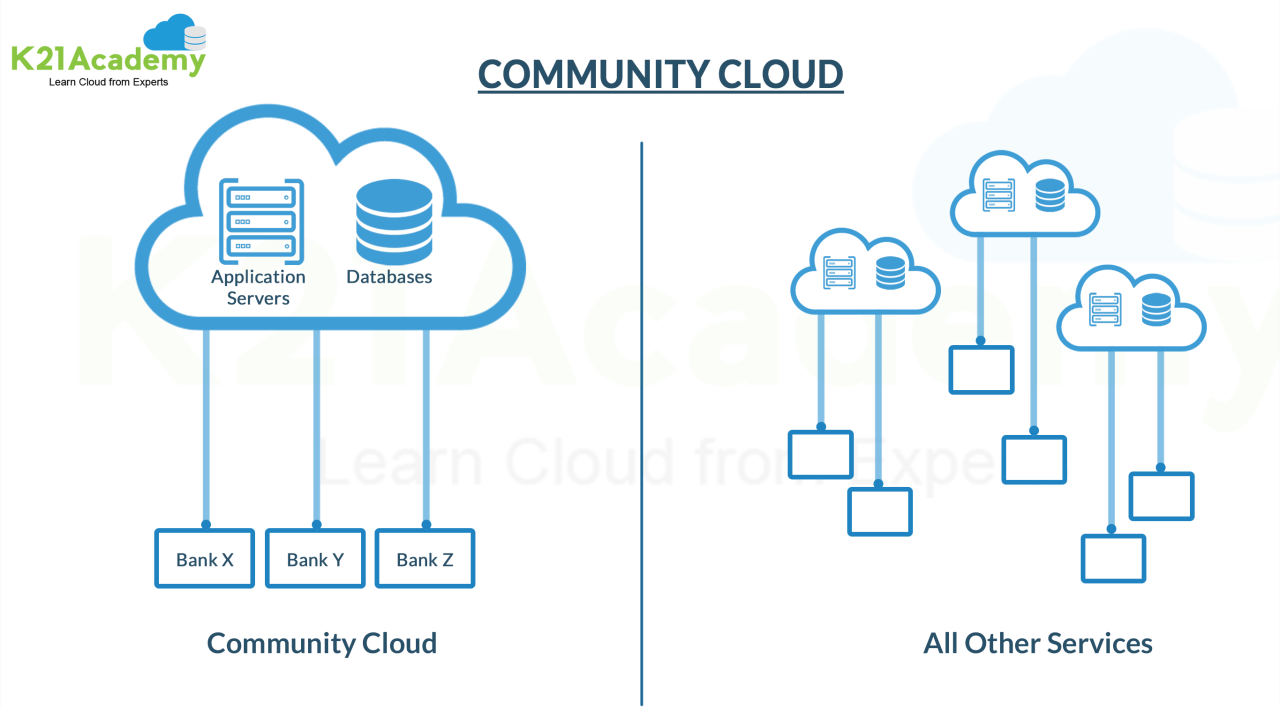Community cloud leverages shared infrastructure among a defined group, offering a compelling alternative to public and private cloud models. This collaborative approach allows organizations, often within the same industry or with shared security needs, to pool resources, reducing individual costs while enhancing security and compliance. The benefits extend beyond cost savings, fostering improved collaboration and data sharing among participating entities, leading to increased efficiency and innovation.
This model particularly shines in sectors with stringent regulatory requirements or a need for high levels of data security, such as healthcare, finance, or government. By establishing a shared, controlled environment, community clouds offer a balance between the cost-effectiveness of public clouds and the enhanced security and control of private clouds.
Benefits of Community Cloud Adoption
Community clouds offer a compelling alternative to public and private cloud deployments, providing a unique blend of shared resources, enhanced security, and improved collaboration. By pooling resources and expertise, participating organizations can unlock significant advantages across various operational aspects. This section details the key benefits realized through community cloud adoption.
Cost Reduction through Shared Resources
The shared nature of community clouds directly translates to significant cost savings. Organizations can leverage economies of scale by sharing infrastructure components such as servers, storage, and networking equipment. This shared responsibility reduces individual capital expenditure (CapEx) and operational expenditure (OpEx) for each participant. For example, a consortium of healthcare providers might share a community cloud to store and process patient data, eliminating the need for each provider to invest in and maintain its own separate infrastructure. This shared investment lowers the overall cost per organization, making advanced technologies and robust infrastructure accessible to even smaller players.
Enhanced Security and Compliance
A well-managed community cloud offers enhanced security and compliance capabilities compared to independently managed private clouds. Shared responsibility models often lead to increased security expertise and resources dedicated to maintaining a secure environment. Community cloud providers typically implement robust security measures, including access control, encryption, and regular security audits. This can lead to improved compliance with industry regulations such as HIPAA (for healthcare) or GDPR (for data privacy), offering peace of mind and reducing the burden of compliance on individual organizations. Furthermore, the collaborative nature of the community allows for the sharing of best practices and security updates, leading to a more secure environment for all participants.
Improved Collaboration and Data Sharing
Community clouds facilitate seamless collaboration and data sharing among participating organizations. A shared platform provides a centralized location for storing and accessing data, fostering efficient workflows and communication. For instance, a community cloud could be used by a group of research institutions to share research data, facilitating collaborative projects and accelerating the pace of scientific discovery. The ability to securely share data across organizational boundaries reduces data silos and promotes more efficient use of resources. This improved collaboration can lead to faster innovation, better decision-making, and stronger partnerships between participating organizations. The controlled access and data governance policies within the community cloud ensure that data sharing remains secure and compliant with relevant regulations.
Community Cloud Governance and Management

Effective governance and management are crucial for the success of any community cloud initiative. Without a well-defined framework, inconsistencies in service delivery, security vulnerabilities, and disputes among participating organizations can easily arise. A robust governance structure ensures that the cloud operates efficiently, securely, and meets the needs of all stakeholders.
Best Practices for Governing a Community Cloud Environment
Establishing clear best practices is paramount for maintaining a secure and reliable community cloud. These practices should address various aspects, from resource allocation and security protocols to conflict resolution and service level agreements. Adherence to these best practices fosters trust and collaboration among participating organizations.
- Establish clear roles and responsibilities: Define the responsibilities of each stakeholder, including governing bodies, cloud providers, and participating organizations.
- Develop comprehensive service level agreements (SLAs): SLAs should Artikel service availability, performance, and support expectations to ensure accountability and transparency.
- Implement robust security policies and procedures: These should encompass access control, data encryption, vulnerability management, and incident response plans.
- Establish a governance board or committee: This body should oversee the overall management of the community cloud, making key decisions and resolving disputes.
- Implement a regular review and audit process: Regular audits ensure compliance with policies and identify areas for improvement.
- Utilize automation tools: Automation can streamline many aspects of cloud management, improving efficiency and reducing manual errors.
- Establish a communication plan: Effective communication channels are essential for keeping stakeholders informed and facilitating collaboration.
Roles and Responsibilities of Stakeholders in a Community Cloud
Understanding the distinct roles and responsibilities of each stakeholder is essential for successful community cloud operation. Clear delineation prevents conflicts and ensures efficient resource management. This includes defining responsibilities for policy development, resource allocation, security management, and dispute resolution.
| Stakeholder | Responsibilities |
|---|---|
| Governing Board | Oversees the overall strategy and governance of the community cloud; sets policies and resolves disputes. |
| Cloud Provider(s) | Provides the underlying infrastructure and services; manages the technical aspects of the cloud. |
| Participating Organizations | Utilize the cloud resources; adhere to established policies and procedures; contribute to the community. |
| Security Officer | Responsible for implementing and maintaining security policies and procedures. |
| Technical Operations Team | Manages the day-to-day operations of the community cloud. |
Sample Governance Policy for a Hypothetical Community Cloud Initiative
This section Artikels a sample governance policy. A real-world policy would need to be tailored to the specific needs and context of the community cloud. This example provides a foundational framework for creating a comprehensive policy.
This policy Artikels the governance structure, roles, responsibilities, and operational procedures for the “Collaborative Research Cloud,” a community cloud initiative for researchers at three collaborating universities (University A, University B, and University C).
- Governance Structure: A steering committee composed of representatives from each university will oversee the community cloud. This committee will be responsible for establishing policies, resolving disputes, and approving major initiatives.
- Resource Allocation: Resource allocation will be based on a pre-defined formula considering factors such as research needs, project priorities, and overall resource availability. A transparent and fair allocation process will be crucial.
- Security: A robust security policy will be implemented, including access control measures, data encryption, and regular security audits. Each university will be responsible for securing its own data and complying with all relevant regulations.
- Service Level Agreements (SLAs): SLAs will be established with the cloud provider to ensure a certain level of service availability, performance, and support.
- Dispute Resolution: A formal dispute resolution process will be established to address any disagreements or conflicts among participating universities.
Data Security and Privacy in Community Cloud
Securing data and ensuring privacy are paramount concerns in any cloud environment, and community clouds, with their shared responsibility model, require particularly robust security measures. Effective data protection strategies must encompass robust encryption, rigorous compliance with relevant regulations, and meticulous access control. This section details the key components of a comprehensive data security and privacy plan for community cloud deployments.
Data security and privacy in a community cloud environment rely on a multi-layered approach, combining technological safeguards with stringent operational procedures. The shared nature of a community cloud necessitates clear delineation of responsibilities and a high degree of transparency and collaboration between participating organizations.
Data Encryption Techniques
Robust data encryption is fundamental to protecting sensitive information stored and processed within a community cloud. This involves employing various encryption methods at different stages of the data lifecycle. Data at rest, for example, might be protected using disk-level encryption, while data in transit would benefit from Transport Layer Security (TLS) or similar protocols. Furthermore, data encryption should be implemented using industry-standard algorithms, such as AES-256, and regularly updated to counter emerging cryptographic threats. Key management practices, including key rotation and secure storage, are also crucial components of a robust encryption strategy. Regular audits and penetration testing help ensure the effectiveness of these encryption measures.
Compliance with Data Privacy Regulations
Community clouds must adhere to a range of data privacy regulations, depending on the jurisdictions in which the cloud operates and the types of data it handles. Examples include GDPR (General Data Protection Regulation) in Europe, CCPA (California Consumer Privacy Act) in California, and HIPAA (Health Insurance Portability and Accountability Act) in the United States for healthcare data. Compliance involves implementing appropriate technical and organizational measures to ensure data is processed lawfully, fairly, and transparently. This includes establishing data processing agreements, implementing data subject access requests, and conducting regular data protection impact assessments (DPIAs) to identify and mitigate potential risks. Ongoing monitoring and auditing are essential to maintain compliance with these ever-evolving regulations.
Access Control and User Permissions
Effective access control is vital to prevent unauthorized access to sensitive data. A community cloud should implement a robust role-based access control (RBAC) system, assigning users specific permissions based on their roles and responsibilities. This granular approach ensures that users only have access to the data and functionalities necessary for their tasks, minimizing the risk of data breaches. Regular review and updates of user permissions are crucial, especially when employees leave the organization or change roles. Multi-factor authentication (MFA) should be mandated for all users, adding an extra layer of security to protect accounts from unauthorized access. Regular security awareness training for users is also essential to reinforce best practices and raise awareness of potential threats.
Community Cloud vs. Other Cloud Models

Choosing the right cloud deployment model is crucial for organizations seeking to leverage cloud computing’s benefits. This section compares community clouds with public and private cloud models, focusing on scalability, flexibility, cost, and suitable use cases. Understanding these differences is key to making an informed decision aligned with specific organizational needs and priorities.
Scalability and Flexibility Comparison
The scalability and flexibility of cloud models differ significantly. Public clouds offer virtually unlimited scalability, easily adjusting resources up or down based on demand. Private clouds provide good scalability within the organization’s infrastructure limits. Community clouds offer a balance, providing more scalability than a private cloud but less than a public cloud, as resources are shared among a defined group. Flexibility also varies; public clouds offer the broadest range of services and customization, private clouds are more limited to the organization’s chosen technologies, and community clouds provide flexibility within the constraints of the community’s shared environment. This is summarized in the table below:
| Feature | Public Cloud | Private Cloud | Community Cloud |
|---|---|---|---|
| Scalability | High, virtually unlimited | Moderate, limited by infrastructure | Moderate to High, limited by community agreement |
| Flexibility | High, wide range of services | Moderate, limited by internal resources | Moderate, determined by community needs and agreements |
Cost Structures and Pricing Models
Public cloud providers typically use a pay-as-you-go model, charging for resources consumed. This can be highly cost-effective for variable workloads but can lead to unpredictable expenses if not managed carefully. Private clouds involve upfront capital expenditure for infrastructure and ongoing operational costs. The total cost of ownership (TCO) can be significant, but it provides better cost predictability. Community clouds offer a shared cost model, distributing infrastructure and operational expenses among participating organizations. This can result in lower costs per organization compared to a private cloud but may require more complex cost allocation and management agreements. For example, a consortium of hospitals sharing a community cloud for medical imaging would divide the infrastructure costs and maintenance responsibilities.
Suitable Scenarios for Each Cloud Model
The choice of cloud deployment model depends heavily on an organization’s specific requirements. Public clouds are ideal for organizations with highly variable workloads, needing rapid scalability, and prioritizing cost-effectiveness over control. Examples include startups, e-commerce businesses, and organizations with fluctuating demand. Private clouds are suitable for organizations with stringent security and compliance requirements, needing greater control over their data and infrastructure, and willing to invest in significant upfront costs. Examples include financial institutions, government agencies, and organizations handling sensitive data. Community clouds are best suited for organizations with shared needs, trust, and collaborative goals, who can benefit from shared resources and reduced costs. Examples include research consortia, industry groups, and government agencies with shared data requirements.
Illustrative Example: Community Cloud for Disaster Response

A community cloud offers a robust and adaptable platform for coordinating disaster response and recovery efforts. By enabling seamless data sharing and resource allocation among various participating organizations – such as government agencies, non-profits, and private sector companies – it streamlines operations and improves efficiency during critical times. Imagine a scenario involving a major hurricane impacting a coastal region.
The immediate aftermath necessitates a rapid, coordinated response. A pre-established community cloud, designed specifically for disaster relief, becomes the central hub for information and resource management. Emergency services can upload real-time data on affected areas, casualty numbers, and infrastructure damage. Simultaneously, volunteer organizations can input details about available resources, such as personnel, supplies, and transportation capabilities. This centralized repository allows for informed decision-making and the efficient allocation of resources to where they are most urgently needed. Furthermore, the community cloud facilitates communication amongst participating organizations, enabling swift collaboration and minimizing duplication of effort.
Data Integrity and Loss Prevention
Maintaining data integrity and preventing data loss in a community cloud during a disaster requires a multi-layered approach. Data replication and redundancy are crucial. Critical data should be replicated across multiple data centers, geographically dispersed to mitigate the risk of a single point of failure. Regular data backups, stored both on-site and off-site, are also essential. A robust version control system allows for the recovery of previous data versions in case of accidental deletion or corruption. The implementation of checksums and other data integrity checks ensures data accuracy and detects any unauthorized modifications. Furthermore, the cloud platform should incorporate automatic failover mechanisms, ensuring seamless service continuity even in the event of hardware or network failures. Regular testing and drills simulate disaster scenarios, allowing organizations to validate their data protection strategies and identify any vulnerabilities.
Security Protocols for Sensitive Data
Protecting sensitive data shared within a community cloud during a crisis is paramount. Robust security protocols must be implemented to prevent unauthorized access and data breaches. This involves strong authentication and authorization mechanisms, including multi-factor authentication, access control lists, and role-based access control. Data encryption, both in transit and at rest, is critical to safeguarding sensitive information. Regular security audits and penetration testing identify and address potential vulnerabilities. The community cloud should comply with relevant data privacy regulations and standards, such as HIPAA or GDPR, depending on the type of data being handled. Incident response plans should be in place to address potential security breaches swiftly and effectively. These plans should Artikel clear procedures for identifying, containing, and remediating security incidents, minimizing the impact on data integrity and operational continuity. Furthermore, regular security awareness training for all users ensures that individuals understand their responsibilities in maintaining data security.
Ultimately, the community cloud model presents a powerful solution for organizations seeking to optimize resource utilization, enhance security, and foster collaboration. By carefully considering the architectural design, governance structure, and security protocols, organizations can reap significant benefits from this innovative approach to cloud computing. The future of community cloud computing looks bright, with advancements in technology promising even greater efficiency, scalability, and security in the years to come.
Community clouds offer a collaborative approach to resource sharing, proving particularly beneficial for groups with shared interests or security needs. Understanding the broader context is crucial, however, and exploring the wider landscape of Cloud Computing Trends Shaping the Future helps illuminate the potential and challenges facing community cloud deployments. Ultimately, successful community cloud initiatives depend on careful planning and a clear understanding of these evolving trends.
Community clouds offer a collaborative approach to resource management, differing significantly from public, private, and hybrid cloud models. Understanding the distinctions between Infrastructure as a Service (IaaS), Platform as a Service (PaaS), and Software as a Service (SaaS) is crucial when considering a community cloud deployment; for a detailed comparison, see this helpful overview: Comparison of IaaS PaaS SaaS A Comprehensive Overview.
Ultimately, the choice of cloud model depends on an organization’s specific needs and the level of control desired within the community context.
